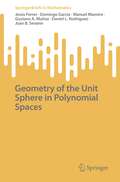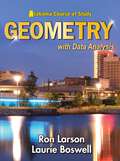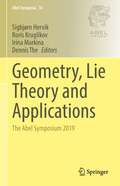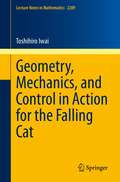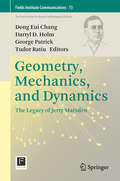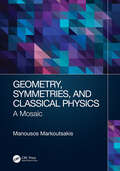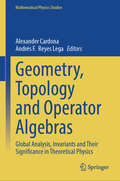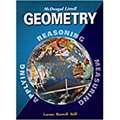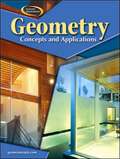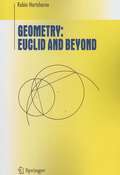- Table View
- List View
Geometry of the Unit Sphere in Polynomial Spaces (SpringerBriefs in Mathematics)
by Manuel Maestre Jesús Ferrer Domingo García Gustavo A. Muñoz Daniel L. Rodríguez Juan B. SeoaneThis brief presents a global perspective on the geometry of spaces of polynomials. Its particular focus is on polynomial spaces of dimension 3, providing, in that case, a graphical representation of the unit ball. Also, the extreme points in the unit ball of several polynomial spaces are characterized. Finally, a number of applications to obtain sharp classical polynomial inequalities are presented.The study performed is the first ever complete account on the geometry of the unit ball of polynomial spaces. Nowadays there are hundreds of research papers on this topic and our work gathers the state of the art of the main and/or relevant results up to now. This book is intended for a broad audience, including undergraduate and graduate students, junior and senior researchers and it also serves as a source book for consultation. In addition to that, we made this work visually attractive by including in it over 50 original figures in order to help in the understanding of all the results and techniques included in the book.
Geometry to Go: A Mathematics Handbook
by Great Source Education GroupGeometry to Go is a reference book. The book covers logic and proof, basic elements of geometry, polygons, measurements, similarity, congruence, transformations, circles, solids, problem solving and non-Euclidean geometry. Also includes an almanac with math prefixes and suffixes, study tips, guidelines for using geometry software, a graphing calculator, test-taking strategies, and tables.
Geometry, Florida
by Randall I. Charles Basia Hall Dan Kennedy Grant Wiggins Art Johnson Laurie E. Bass Stuart J. MurphyNIMAC-sourced textbook
Geometry, Its Elements and Structure: Second Edition
by Alfred S. Posamentier Robert L. BannisterWith its coverage of plane, solid, coordinate, vector, and non-Euclidean geometry, this text is suitable for high school, college, and continuing education courses as well as independent study. Each new topic is carefully developed and clarified with many examples. More than 2,000 illustrations help students visualize the problems. Every set of exercises is preceded by numerous examples with detailed solutions. Chapters include a vocabulary list, set of review exercises, chapter test, and topics for suggested research. Periodic cumulative reviews offer the opportunity for self-evaluation.Co-written by Alfred S. Posamentier, a bestselling author of high school and university textbooks and pioneer of educational standards, this volume is geared toward high school geometry classes and contains standard material for numerous state competencies. An electronic solutions manual is available upon request.
Geometry, Lie Theory and Applications: The Abel Symposium 2019 (Abel Symposia #16)
by Sigbjørn Hervik Boris Kruglikov Irina Markina Dennis TheThis book consists of contributions from the participants of the Abel Symposium 2019 held in Ålesund, Norway. It was centered about applications of the ideas of symmetry and invariance, including equivalence and deformation theory of geometric structures, classification of differential invariants and invariant differential operators, integrability analysis of equations of mathematical physics, progress in parabolic geometry and mathematical aspects of general relativity.The chapters are written by leading international researchers, and consist of both survey and research articles. The book gives the reader an insight into the current research in differential geometry and Lie theory, as well as applications of these topics, in particular to general relativity and string theory.
Geometry, Mechanics, and Control in Action for the Falling Cat (Lecture Notes in Mathematics #2289)
by Toshihiro IwaiThe falling cat is an interesting theme to pursue, in which geometry, mechanics, and control are in action together. As is well known, cats can almost always land on their feet when tossed into the air in an upside-down attitude. If cats are not given a non-vanishing angular momentum at an initial instant, they cannot rotate during their motion, and the motion they can make in the air is vibration only. However, cats accomplish a half turn without rotation when landing on their feet. In order to solve this apparent mystery, one needs to thoroughly understand rotations and vibrations. The connection theory in differential geometry can provide rigorous definitions of rotation and vibration for many-body systems. Deformable bodies of cats are not easy to treat mechanically. A feasible way to approach the question of the falling cat is to start with many-body systems and then proceed to rigid bodies and, further, to jointed rigid bodies, which can approximate the body of a cat. In this book, the connection theory is applied first to a many-body system to show that vibrational motions of the many-body system can result in rotations without performing rotational motions and then to the cat model consisting of jointed rigid bodies. On the basis of this geometric setting, mechanics of many-body systems and of jointed rigid bodies must be set up. In order to take into account the fact that cats can deform their bodies, three torque inputs which may give a twist to the cat model are applied as control inputs under the condition of the vanishing angular momentum. Then, a control is designed according to the port-controlled Hamiltonian method for the model cat to perform a half turn and to halt the motion upon landing. The book also gives a brief review of control systems through simple examples to explain the role of control inputs.
Geometry, Mechanics, and Dynamics
by Dong Eui Chang Darryl D. Holm George Patrick Tudor RatiuThis book illustrates the broad range of Jerry Marsden's mathematical legacy in areas of geometry, mechanics, and dynamics, from very pure mathematics to very applied, but always with a geometric perspective. Each contribution develops its material from the viewpoint of geometric mechanics beginning at the very foundations, introducing readers to modern issues via illustrations in a wide range of topics. The twenty refereed papers contained in this volume are based on lectures and research performed during the month of July 2012 at the Fields Institute for Research in Mathematical Sciences, in a program in honor of Marsden's legacy. The unified treatment of the wide breadth of topics treated in this book will be of interest to both experts and novices in geometric mechanics. Experts will recognize applications of their own familiar concepts and methods in a wide variety of fields, some of which they may never have approached from a geometric viewpoint. Novices may choose topics that interest them among the various fields and learn about geometric approaches and perspectives toward those topics that will be new for them as well.
Geometry, Symmetries, and Classical Physics: A Mosaic
by Manousos MarkoutsakisThis book provides advanced undergraduate physics and mathematics students with an accessible yet detailed understanding of the fundamentals of differential geometry and symmetries in classical physics. Readers, working through the book, will obtain a thorough understanding of symmetry principles and their application in mechanics, field theory, and general relativity, and in addition acquire the necessary calculational skills to tackle more sophisticated questions in theoretical physics. Most of the topics covered in this book have previously only been scattered across many different sources of literature, therefore this is the first book to coherently present this treatment of topics in one comprehensive volume. Key features: Contains a modern, streamlined presentation of classical topics, which are normally taught separately Includes several advanced topics, such as the Belinfante energy-momentum tensor, the Weyl-Schouten theorem, the derivation of Noether currents for diffeomorphisms, and the definition of conserved integrals in general relativity Focuses on the clear presentation of the mathematical notions and calculational technique
Geometry, Topology and Operator Algebras: Global Analysis, Invariants and Their Significance in Theoretical Physics (Mathematical Physics Studies)
by Alexander Cardona Andrés F. Reyes LegaThis book offers a comprehensive exploration of contemporary intersections between geometry, topology, and theoretical physics, emphasizing their mathematical foundations and applications. Originating from lectures presented by experts during two summer schools held in Villa de Leyva, Colombia, the book reflects the synergy between global analysis, operator algebras, and their role in modern physics. The chapters present state-of-the-art developments on a wide range of topics: the geometry and topology of foliations, affine manifolds, C*-algebras, and the pseudo-differential calculus of boundary value problems. These are enriched by applications to the theory of topological quantum matter. The book is suitable for graduate students and researchers, offering detailed introductions to advanced topics such as the longitudinal index theorem for foliations, the geometry of the Poincaré half-space in a C*-algebra, and mathematical frameworks for topological matter. With a balance of foundational material and novel insights, it serves as both a learning resource and a reference for advanced studies at the intersection of mathematics and physics.
Geometry, Topology and Physics
by Mikio NakaharaDifferential geometry and topology have become essential tools for many theoretical physicists. In particular, they are indispensable in theoretical studies of condensed matter physics, gravity, and particle physics. Geometry, Topology and Physics, Second Edition introduces the ideas and techniques of differential geometry and topology at a level suitable for postgraduate students and researchers in these fields.The second edition of this popular and established text incorporates a number of changes designed to meet the needs of the reader and reflect the development of the subject. The book features a considerably expanded first chapter, reviewing aspects of path integral quantization and gauge theories. Chapter 2 introduces the mathematical concepts of maps, vector spaces, and topology. The following chapters focus on more elaborate concepts in geometry and topology and discuss the application of these concepts to liquid crystals, superfluid helium, general relativity, and bosonic string theory. Later chapters unify geometry and topology, exploring fiber bundles, characteristic classes, and index theorems. New to this second edition is the proof of the index theorem in terms of supersymmetric quantum mechanics. The final two chapters are devoted to the most fascinating applications of geometry and topology in contemporary physics, namely the study of anomalies in gauge field theories and the analysis of Polakov's bosonic string theory from the geometrical point of view.Geometry, Topology and Physics, Second Edition is an ideal introduction to differential geometry and topology for postgraduate students and researchers in theoretical and mathematical physics.
Geometry, Topology, and Dynamics in Negative Curvature
by C. S. Aravinda F. T. Farrell J. F. LafontThe ICM 2010 satellite conference 'Geometry, Topology and Dynamics in Negative Curvature' afforded an excellent opportunity to discuss various aspects of this fascinating interdisciplinary subject in which methods and techniques from geometry, topology, and dynamics often interact in novel and interesting ways. Containing ten survey articles written by some of the leading experts in the field, this proceedings volume provides an overview of important recent developments relating to negative curvature. Topics covered include homogeneous dynamics, harmonic manifolds, the Atiyah Conjecture, counting circles and arcs, and hyperbolic buildings. Each author pays particular attention to the expository aspects, making the book particularly useful for graduate students and mathematicians interested in transitioning from other areas via the common theme of negative curvature.
Geometry: 1,001 Practice Problems For Dummies (+ Free Online Practice)
by Amber Kuang Allen Maeasy, medium, and hardFree one-year access to the online questions bankWith 1,001 Geometry Practice Problems For Dummies, you'll get the practice you need to master geometry and gain confidence in the classroom.
Geometry: A Common Core Curriculum
by Houghton Mifflin Harcourt Publishing Company StaffGeometry A Common Core Curriculum
Geometry: A Comprehensive Course
by Dan Pedoe"A lucid and masterly survey." — Mathematics GazetteProfessor Pedoe is widely known as a fine teacher and a fine geometer. His abilities in both areas are clearly evident in this self-contained, well-written, and lucid introduction to the scope and methods of elementary geometry. It covers the geometry usually included in undergraduate courses in mathematics, except for the theory of convex sets. Based on a course given by the author for several years at the University of Minnesota, the main purpose of the book is to increase geometrical, and therefore mathematical, understanding and to help students enjoy geometry.Among the topics discussed: the use of vectors and their products in work on Desargues' and Pappus' theorem and the nine-point circle; circles and coaxal systems; the representation of circles by points in three dimensions; mappings of the Euclidean plane, similitudes, isometries, mappings of the inversive plane, and Moebius transformations; projective geometry of the plane, space, and n dimensions; the projective generation of conics and quadrics; Moebius tetrahedra; the tetrahedral complex; the twisted cubic curve; the cubic surface; oriented circles; and introduction to algebraic geometry.In addition, three appendices deal with Euclidean definitions, postulates, and propositions; the Grassmann-Pluecker coordinates of lines in S3, and the group of circular transformations. Among the outstanding features of this book are its many worked examples and over 500 exercises to test geometrical understanding.
Geometry: Applying, Reasoning, Measuring (Mcdougal Littell High School Math Ser.)
by Ron Larson Laurie BoswellGeometry, like much of mathematics and science, developed when people began recognizing and describing patterns. In this course, you will study many amazing patterns that were discovered by people throughout history and all around the world. You will also learn to recognize and describe patterns of your own. Sometimes, patterns allow you to make accurate predictions.
Geometry: Concepts and Applications
by Mcgraw-Hill StaffAn ideal program for struggling students Geometry: Concepts and Applications covers all geometry concepts using an informal approach.
Geometry: Euclid And Beyond (Undergraduate Texts In Mathematics)
by Robin HartshorneIn recent years, I have been teaching a junior-senior-level course on the classi cal geometries. This book has grown out of that teaching experience. I assume only high-school geometry and some abstract algebra. The course begins in Chapter 1 with a critical examination of Euclid's Elements. Students are expected to read concurrently Books I-IV of Euclid's text, which must be obtained sepa rately. The remainder of the book is an exploration of questions that arise natu rally from this reading, together with their modern answers. To shore up the foundations we use Hilbert's axioms. The Cartesian plane over a field provides an analytic model of the theory, and conversely, we see that one can introduce coordinates into an abstract geometry. The theory of area is analyzed by cutting figures into triangles. The algebra of field extensions provides a method for deciding which geometrical constructions are possible. The investigation of the parallel postulate leads to the various non-Euclidean geometries. And in the last chapter we provide what is missing from Euclid's treatment of the five Platonic solids in Book XIII of the Elements. For a one-semester course such as I teach, Chapters 1 and 2 form the core material, which takes six to eight weeks.
Geometry: Explorations and Applications
by Miriam A. Leiva Stuart J. Murphy Douglas B. Aichele Patrick W Hopfensperger Marguerite M. Mason Vicki J. Schell Matthias C. VheruThis book will help you use mathematics in your daily life and prepare you for success in future courses and careers.
Geometry: Explorations and Applications, Practice Workbook
by Mcdougal LittellThis book contains a good collection of math exercises and examples.
Geometry: GRE Math Strategy Guide 2nd Edition
by The Editors ar the Manhattan GREThis volume guides students through the intricacies of shapes, planes, lines, angles, and objects, illustrating every geometric principle, formula, and problem type tested on the GRE.
